Webinar
Josh Bersin + Degreed - Skills, AI, and the Future of Learning
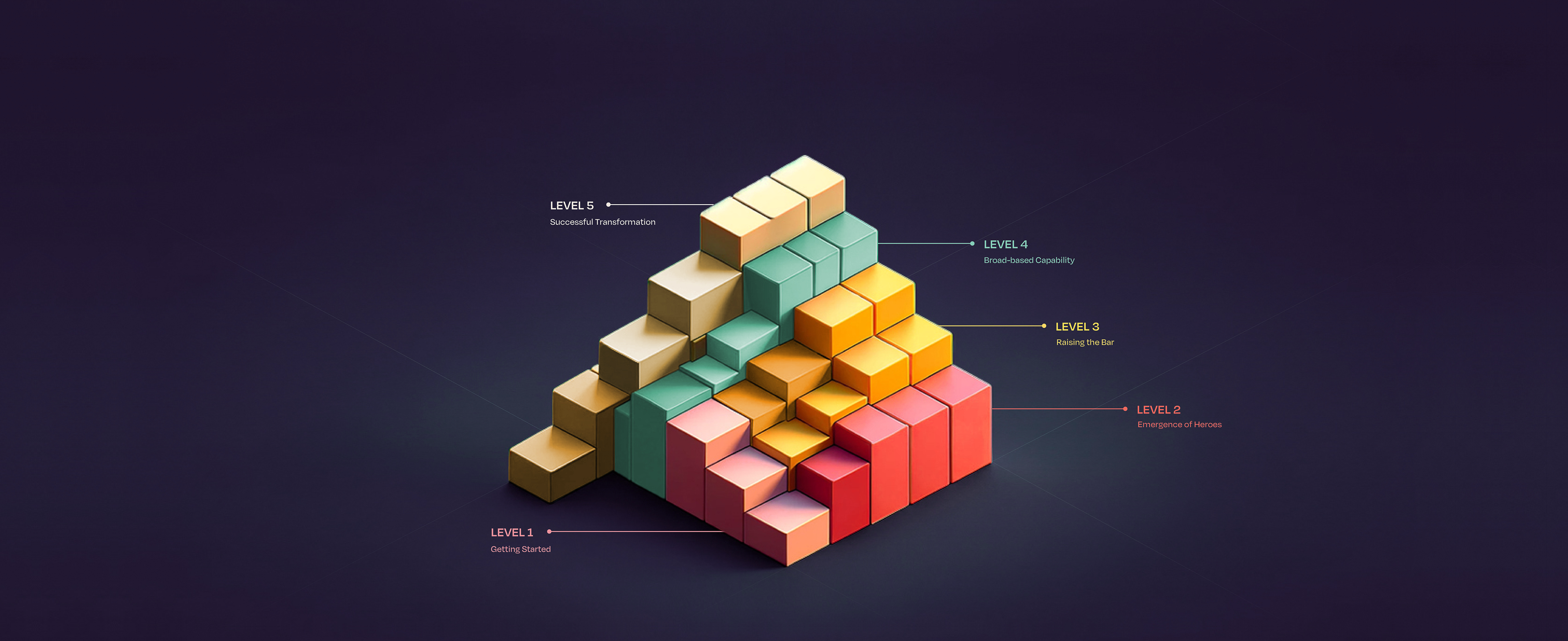
Part 4: The five levels of skills transformation

Kian Katanforoosh
We know success when we see it. But what we rarely see at first glance is the work that came before the success — the many steps and benchmarks that a person or organization had to finish before reaching the end result.
For skills-based organizations, success and maturity can’t be achieved overnight.
In the first three articles of this series on skills-based organizations, I looked at the concept of skills-based organizations and their defining characteristics; examined the different measurement instruments that can be used to follow progress; and gave a detailed overview of the incentives that skills-based organizations use to drive growth. In this article, I’ll walk readers through the five levels of skills transformation and how organizations can advance from the earliest stages of skills development to a fully successful transformation.
Without visibility into skill levels at an individual and organization-wide level, business leaders lack the information they need to make precise interventions to drive employee growth and company-wide innovation. At Workera, we’ve measured enterprises across a range of industries and have identified several workforce “signatures” — common examples of how skill levels are distributed throughout the organization. Placing the skills transformation in context enables leaders to identify the champions and eager learners in their organization, as well as the skeptics who may need more encouragement to move forward. Following the examples set by other companies with similar workforce signatures can make it easier for organizations to take specific actions and advance to the next level of transformation.
Organizations that reach the final stage of skills transformation benefit from a broad-based capability across many roles and domains. This allows business leaders to mix and match people to different projects, processes and tasks without needing to overcome a substantial learning curve associated with each change.
Let’s take a look at how we define and establish benchmarks for skills transformations.
How we measure skills transformations
No two organizations are the same: each will have its own mission, goals, roles, and skills. To measure an organization’s skills transformation, we need to put each level into the context of that organization’s unique priorities.
At Workera, we’ve developed the following terms through years of helping large enterprises drive digital transformation through measured learning and skills development:
- Roles: An AI engineer doesn’t require the same set of skills as a finance director. Each role is defined by its underlying domains and skills rather than by a concrete job description. In general, broad “roles” can help an organization understand what domains that person needs to study and master, but more tactical decisions regarding who works on what task or project should be dictated solely by skills as opposed to simply job titles.
- Domains: “Data science” and “cloud computing” aren’t skills — they’re broad categories that encompass dozens of individual, measurable skills. We call these domains — each role will include multiple domains, which will themselves be broken down into dozens of skills. For example, an AI Engineer will be measured across domains including AI Fairness, Deep Learning, MLOps Culture, and TensorFlow.
- Skills: A skill is not a broad, generic attribute or accomplishment — it’s a granular, highly defined component of a broader domain. If the domain is “building a house,” then that domain can be broken up into dozens or even hundreds of individual skills, from installing electrical wiring to choosing paint colors to laying carpet.
- Proficiency levels: On an individual level, employees will reach different levels of proficiency for different skills. The first proficiency level for a skill or domain is “beginning”: at this stage, an employee is only just starting to understand what the skill entails and recall relevant information. During the “developing” stage, an employee has reached a specific target score and can now interpret, evaluate, and communicate information relative to that skill. At the “accomplished” level, the employee can be considered an expert — capable of deploying that skill in sophisticated tasks like designing, building, and engineering.
- Target scores: Each skill is measured according to a range of target scores. Workera’s computer adaptive testing (CAT) measures each skill on a scale from 0–300, with skill levels measured according to these target scores: Beginning (0–100), Developing (101–200), and Accomplished (201–300).
Five levels of skills transformation
Once you’ve defined your roles, domains, and skills, you can then begin to assess individual employees and understand where your organization is within its skills transformation in each domain. These transformations can evolve organically as early leaders and high achievers chart a course for others to follow. However, careful planning and AI-backed tools can help the organization to progress more quickly to the final level.
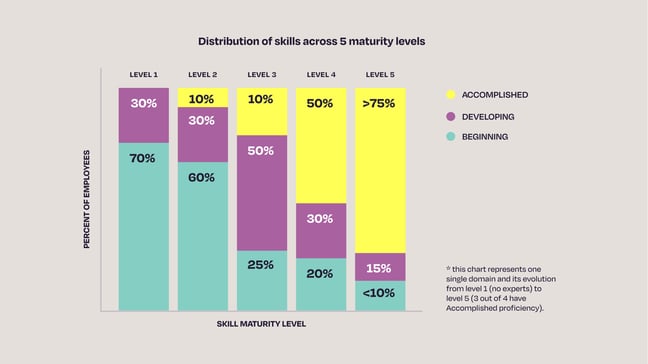
Here are the five levels of skills transformation/domain maturity as defined by Workera, identified and tested across a customer base of some of the world’s largest, most recognizable organizations:
- Level 1: Getting Started - Every organization has to start somewhere. At Level 1, the percentage of employees who have reached the Accomplished level in a particular domain is 0%. There is a long road ahead, and this is the stage at which leaders need to foster understanding and conviction among their employees. Executives should be ready to explain and justify why each domain is necessary for the organization and its long-term goals. An organization at Level 1 will typically have to recruit and hire experts to begin setting a new standard, otherwise the ceiling will remain too low for the team as a whole.
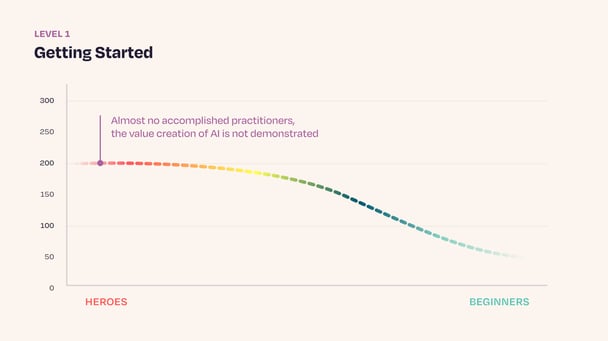
- Level 2: Emergence of Heroes - At Level 2, the percentage of employees who have reached the Accomplished level in a particular domain is higher than 0% but lower than 20%. At this level, it’s important to highlight and celebrate those who have become Accomplished. These employees will serve as role models for the rest of the organization, demonstrating what needs to be done to achieve an organization-wide skills transformation. Organizations at Level 2 will have some experts, but they are typically not positioned well in the organization to drive forward momentum. Executives will need to reallocate these stronger employees so that they’re able to provide the maximum benefit to their teams.
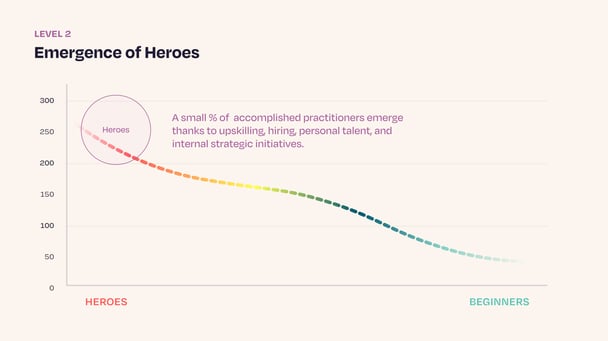
- Level 3: Raising the Bar - At this level, the percentage of employees who are Accomplished in the domain is greater than 20% but lower than 50%. This is a turning point for the organization, as the accomplished role models will have reached a critical mass to help lift the remainder of the organization up to higher skill levels. At Level 3, role models can be chosen to curate team-specific content, providing a clear roadmap for their colleagues to progress through the maturity levels. Imagine a software development team that has an amazing coder — that person is going to raise the bar for everyone else in the team, pushing them to reach the next level.
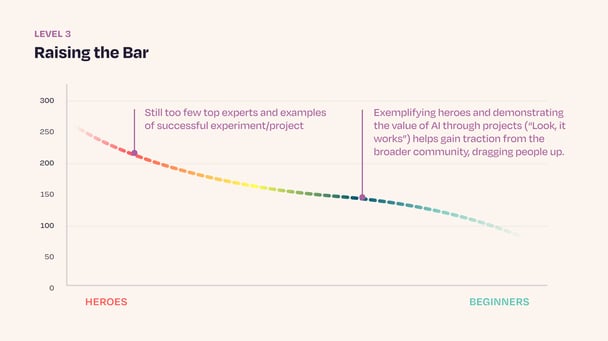
- Level 4: Broad-based Capability - At Level 4, more than 50% of employees have reached the Accomplished level, yet the organization will have not yet reached the two final requirements for a completely successful transformation. This is the point at which organizations should establish best practices for coaching and mentoring, helping those who are just beginning or developing to advance quickly. At Level 4, organizations can establish a mentorship pyramid: the accomplished experts in each role can take responsibility for mentoring those who may be slightly less experienced and pull them up to the next level. A culture of excellence is taking shape, and the experts themselves are motivated to help their colleagues break through to the final level.
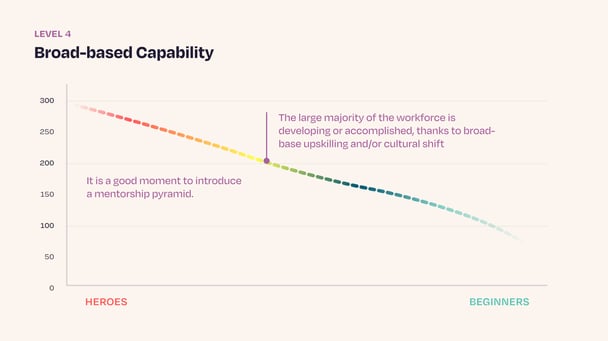
- Level 5: Successful Transformation - At the final level of skills transformation, more than 75% of employees are accomplished in their roles, and less than 10% are still at the beginning level. For these organizations, the vast majority of employees can contribute to projects with confidence and flexibility. In an organization that has reached this level, those who aren’t accomplished in their roles are outliers — they’re inherently required to upskill quickly in order to keep pace with the majority of team members who are accomplished. An organization that has achieved a successful skills transformation will be able to build and innovate quickly, while also being able to onboard employees into a culture that truly values learning, development and growth.
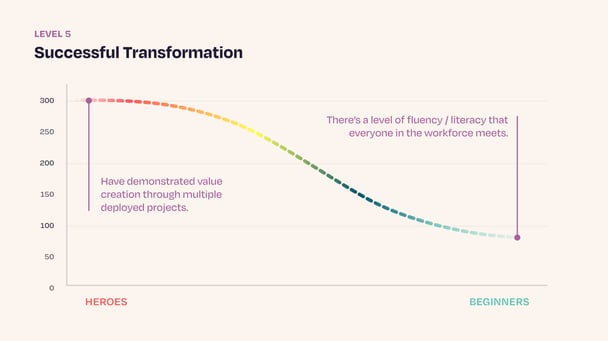
Roadmap to success
Progress doesn’t take place in a vacuum.
The more information an organization has about its employees and their abilities, the more it will be able to make precise decisions around both employee development and overall business goals. The five levels of skills transformation provide a clear roadmap for organizational success. By following your workforce through these stages of development, and by applying different mentorship and development tactics at the right moment, you can more quickly and efficiently achieve the end goal — a successful, mature skills-based organization.
In the final article of this series, we’ll zoom in on skills at a much more precise, granular level. Skills KPIs provide employees with clear expectations on how to advance and grow — we’ll look at what defines a successful KPI and place them in the context of a larger skills-based organization.
Skills-based organizations
What makes an organization skills-based?
A skills-based organization is one that focuses on the skills of its workforce as the primary factor when structuring teams, assigning roles, developing people, and driving business strategy.
Measuring and managing skills to drive growth and learning
Today’s executives are leading their businesses — and their employees — through a period of unprecedented technological change.
Using incentives to foster employee growth
What drives someone to improve themselves? Is it enough to let people find their own motivation and work their way to the top? Or should an organization take a more active role in fostering employee growth and skills development?
5 levels of Skill Transformation
Step-by-step guide to achieving a comprehensive skills transformation, including five levels of progression within an organization’s journey
Choosing the Right Skills KPIs
This concluding article in our comprehensive series provides an in-depth look into the strategic selection and application of Key Performance Indicators (KPIs). Learn to navigate and ensure your organization's skill development aligns with targeted business outcomes
Understand. Develop. Mobilize
Unlock the full potential of your workforce
Learn how Workera can power digital transformation and produce measurable results across your enterprise.
Get a Demo